What is the background of the standards?
The "Opinions of the Central Committee of the Communist Party of China and the State Council on In-depth Pollution Prevention and Control" clearly pointed out that during the "14th Five-Year Plan" period, it is necessary to vigorously strengthen the coordinated control of fine particulate matter (PM2.5) and ozone. Volatile organic compounds (VOCs) are important precursors for the formation of PM2.5 and ozone, and some VOCs are toxic substances and odorous substances, which are binding targets for the "14th Five-Year Plan". The printing industry is an important industry for VOCs emissions. The overall scale of China's printing industry ranks second in the world, with nearly 100,000 enterprises of various types and a total output value of about 1.4 trillion yuan. At present, the management of air pollutant emissions in the printing industry implements the "Comprehensive Emission Standards for Air Pollutants" (GB 16297-1996) and the "Standards for the Control of Unorganized Emissions of Volatile Organic Compounds" (GB 37822-2019). The emission control requirements are loose, which cannot support the current demand for the whole process control of industrial VOCs in my country. It is urgent to formulate special industry standards, implement the requirements of precise, scientific and legal pollution control, and further standardize the management of industrial pollution emissions.
2. What are the characteristics of this standard on emission control?
This standard is based on the whole-process management and control idea from source reduction, process control to end treatment, organized emission and unorganized emission control are two-pronged, and further regulates the pollution discharge behavior of printing enterprises.
(1) Strengthen source and process control, standardize fugitive emission management
Unorganized emission control is a difficult point in the control of VOCs in the printing industry. According to the characteristics of the process, the standard clearly stipulates the control requirements for the storage, transfer and transportation of VOCs materials such as ink, diluent, fountain solution and adhesive, and the pre-press, printing and post-press processes. In addition, this standard puts forward the recommended value of VOCs monitoring concentration limit in the factory area, which shall be implemented by the local government according to the needs of local environmental protection, and the fugitive emission status in the factory area shall be monitored. Through the above control measures, the whole process of fugitive emissions can be controlled.
(2) Implement concentration and total volume control, and improve organized emission control
The air pollutants produced in the printing production process are mainly VOCs and particulate matter, of which the amount of particulate matter is relatively small, and VOCs are the main pollutants, and most of them are toxic substances. In order to comprehensively control the emission of air pollutants in the printing industry, and at the same time simplify the pollutant control projects as much as possible, the form of "comprehensive indicators + characteristic pollutants" is adopted to ensure the strictness of emission supervision. The comprehensive indicator is non-methane total hydrocarbons (NMHC), which controls the total emissions of VOCs. The characteristic pollutant project highlights key points, considers photochemical reactivity and toxicity, and controls benzene and benzene series.
While the standard continues to use the emission concentration limit control method, it further implements differentiated control according to the initial emission of the enterprise. For enterprises with large emissions, dual control of emission concentration and removal efficiency is implemented; for enterprises with small emissions, only the concentration index requirements need to be met. In addition, for enterprises that use raw and auxiliary materials that meet the national regulations on low-VOCs content products, the processing efficiency requirements are not implemented, and enterprises are encouraged to use water-based inks and other source measures to reduce total emissions.
3. How feasible is the implementation of the standard?
In recent years, Beijing-Tianjin-Hebei and surrounding areas, the Yangtze River Delta, and the Pearl River Delta have issued relevant local standards. Printing companies in the region have taken the lead in upgrading process equipment and environmental protection facilities, and accumulated mature cases of standard-compliant technologies, which serve as standard implementation Laid the technical foundation. Industry associations and relevant experts agreed that this standard can reflect the concerns of the industry and is highly instructive and operable, and they urgently hope that the standard will be released. At present, publication printing companies can achieve emission standards through source prevention technologies such as replacement of raw and auxiliary materials, and do not need to upgrade and transform; Or the demand has a contraction effect, which is at an acceptable level for the industry. In the process of formulating the standard, public opinions have been publicly solicited, and industry associations and related companies have been fully communicated. The market has already expected it, and related companies have already started preparations for transformation. Existing enterprises will implement the standard from July 1, 2024, giving enterprises sufficient time for upgrading and transformation.
4. What are the environmental and social benefits of standard implementation?
The implementation of this standard has good environmental benefits. It can effectively reduce toxic and harmful substances discharged into the environment, help protect the health of the surrounding public, play a positive role in improving ambient air quality, and meet the public's needs for a good ecological environment. The implementation of this standard will further promote fair competition in the industry, effectively solve the problem of "bad money driving out good money", and help to establish a more fair and orderly market environment. At the same time, printing industry enterprises will be guided to adopt source, process and end treatment measures to reduce organic waste gas emissions and promote the green development of the industry.
The 5th China International VOCs Monitoring and Governance Industry Innovation Summit in 2023 will be held in Suzhou from June 14th to 15th, 2023. , environmental protection departments, associations/societies, industrial parks, equipment and service providers, industrial waste production enterprises, safety and environmental protection departments, design units, scientific research institutions, universities, monitoring central stations, etc. to jointly discuss the status of VOCs exhaust gas, the latest technology and equipment, Industry opportunities, difficulties and pain points in monitoring and governance.
meeting information
meeting time
June 14-15, 2023
meeting place
Jiangsu•Suzhou
Organizational Unit
VOCs Monitoring and Governance Industry Innovation Summit Organizing Committee
Low Carbon Environmental Circle
Anhui Tongju Culture Media Co., Ltd.


